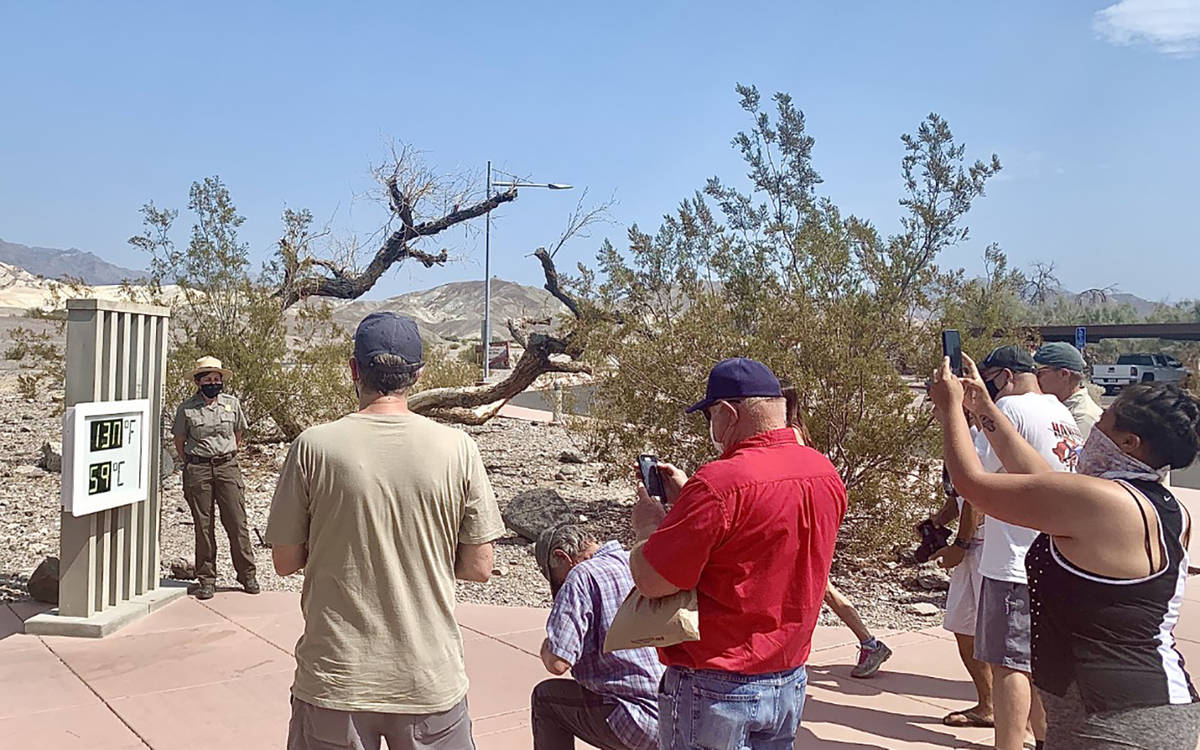
In terms of summer heat, Death Valley National Park broke numerous heat records for 2020.
As stated in a park news release, June through August had an average day and night combined temperature of 102.7 degrees.
“This makes 2020 the fourth hottest summer on record, following 2018 which was the first, 2017 the second, and 2016 the third,” and marking a continued record of a changing climate,” according to Public Information Officer Jennette Jurado.”
The 2020 heat highlights to date show that Death Valley experienced 35 days over 120 degrees, where the normal ratio is 18.4 days.
The highlights also stated that the park experienced eight days with high temperatures exceeding 125 degrees, while the normal comparison is 2.9 days.
At least six nights at the park saw temperatures above 109 degrees, while the normal is 0.5.
“May, August, and September all saw the hottest day or night ever recorded for that month,” Jurado stated in the release, “130 degrees on August 16th, was the hottest temperature recorded in the park since 1913, and possibly the hottest temperature in the world since 1931. A final verification process was overseen by a climate extremes committee. August average daily and nightly temperatures ranked it as the second hottest August on record however, August’s daily high temperatures average to be 118.8 degrees which set a record as the hottest average high temperature for the month.”
The release went on to note that August 17th had a high of 127 degrees and an overnight low of 104, for an average of 115.5 degrees, which is tied for the hottest average daily temperature ever recorded.
“Heat records were set for both daily high, and highest daily low temperatures across many of the hottest months of the year,” Jurado said. “Six in May, one in June, one in July, 12 in August, and in September. Living in such an extreme environment requires certain precautions and adjustments for park staff and the local communities.”
Jurado went on to note that the park has a strict heat-safety work policy, requiring cool down and hydration, after working in extreme heat conditions.
Additionally, Jurado noted that ground temperatures add heat to water pipes in the region, resulting in extremely hot water coming from the tap.
“To adjust for this, residents turn down their hot water heaters and use them as a reservoir to cool water down to room temperature, so tepid water comes from turning on the hot water faucet, and hot water comes from the cold faucet settings,” she said.
Regarding summertime visitors at the park, Jurado noted that there are stretches of roadways where signs are posted recommending that air conditioning be shut off to avoid car engines from overheating.
“As vehicles leave the extreme heat of the lower valleys and climb over mountain passes, overheated engines are a real risk,” she said. “This summer saw two vehicle fires as a result of overheated engines, and numerous vehicle breakdowns. Turning off air conditioning might be uncomfortable but it reduces exertion on the engine.”
Additionally, Jurado noted that ‘heat tourism’ brings visitors to the park to experience the extreme conditions.
“With this, there were multiple search and rescues, and tragically, also visitor fatalities where heat was likely a factor,” she said. “Limiting time outside of air conditioning to just a few minutes at a time can help lead to a safer summer visit. As the coolest hours of the day are usually 4 a.m. to 6 a.m., local residents usually get up pre-dawn to walk their dogs and get exercise.”
Park superintendent Mike Reynolds spoke about how Death Valley is known for its extreme temperatures throughout the year.
“This year certainly didn’t disappoint when it comes to heat,” he said. “It is exciting to live and work in a place that is literally the hottest place on earth. I’m proud to work with a resilient team of employees who have chosen to embrace the heat and carry out the mission of the National Park Service here.”
Moreover, park officials pointed out that as the region moves into the fall season while other areas across the nation start cooling down, Death Valley National Park is still seeing temperatures over 110 degrees, and the park usually continues to have temperatures in excess of 100 degrees well into the month of October.
Trip planning resources can be found on the park’s website, advising visitors to plan and prepare for safe and memorable visits to the park.
For additional information logon to www.nps.gov/deva.
Contact reporter Selwyn Harris at sharris@pvtimes.com. On Twitter: @pvtimes